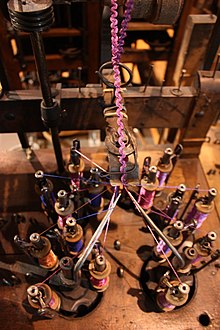Rickrack

Rickrack is a flat piece of braided trim, shaped like a zigzag. It is used as a decorative element in clothes or curtains.[2] Before the prevalence of sewing machines and overlockers, rickrack was used to provide a finished edge to fabric,[3] and its popularity was in part due to its sturdiness and ability to stand up to harsh washing conditions.[4] Rickrack is produced using a variety of fibers, including cotton, polyester, wool, and metallic fibers, and is sold in a variety of sizes and colors.[4]
Invented in the mid-19th century, it took its modern form and current name around 1880.[5] Rickrack's popularity peaked in the 1970s and is associated with the Little House on the Prairie. Several designs of formal and up-market girls' dresses with it on as a decoration became popular in the 1950s and 1960s.[citation needed]
History


In the 1860s, rickrack was known as waved crochet braid or waved lacet braid.[6]
During the 1890s, American home sewists used imported European rickrack as decorative edgings for dresses, aprons, and lingerie. Rickrack was also stitched into lace elements, which were then used to decorate bedding and other home linens. Between the 1890s and 1910s, rickrack experienced a decrease in popularity.[7]
During the 1910s, rickrack experienced a resurgence in popularity, and American manufacturers began producing rickrack to supply to the domestic market. Among other uses, this rickrack was incorporated into crocheted lace. Books of designs, such as Nufashond Rick Rack Book, helped to popularize the craft.[7]
In rural America in the 1930s, 1940s, and 1950s, rickrack was used to decorate feed sack dresses. These dresses were worn as everyday attire, and were constructed from the large cotton bags that flour, chicken feed, and other goods were shipped in.[8] Since the food had to be shipped in fabric bags anyway, the flour mills competed with each other by using attractive, colorful fabrics that the buyer could either resell or upcycle into dresses, aprons, nightgowns, dishtowels, and other clothing and household items.[9] Adding trim like rickrack was a way to reduce the stigma around needing to use whatever fabric was available, rather than buying it from a store.[9]
References
- ^ "Handmade Aprons, photo page 2". Love To Sew Studio.
- ^ Pickett, Joseph P.; et al., eds. (2000). "rickrack". The American Heritage Dictionary of the English Language (Fourth ed.). Boston: Houghton Mifflin Company. p. 1498. ISBN 0-395-82517-2. Retrieved 2019-09-14.
- ^ Lee, Linda (2000). Sewing Edges and Corners: Decorative Techniques for Your Home and Wardrobe. Taunton. p. 121. ISBN 978-1-56158-418-5.
- ^ a b "Rickrack Trims". Better Homes & Gardens. Meredith Corporation. 2015-08-26. Retrieved 2019-03-05.
- ^ "rickrack". Merriam-Webster.com Dictionary. Merriam-Webster.
- ^ "Waved Crochet Braid (aka ric-rac)". Genesee Country Village & Museum. 2012-07-14. Archived from the original on 2016-06-24. Retrieved 2019-03-05.
- ^ a b "Brisk Movement in Art Embroidery Field". Notions and Fancy Goods. Vol. 50, no. 4. New York: McCreedy Publishing Company. April 1916. pp. 40–41. Retrieved 2019-01-16.
- ^ Buckel, Natalya Rachael (May 2010). Feed-sack fashion in rural Appalachia: a social history of women's experiences in Ashe County, North Carolina (1929–1956) (PDF) (Thesis). Appalachian State University. Retrieved 16 January 2019.
- ^ a b Onion, Rebecca (2017-07-21). "How Depression-Era Women Made Dresses Out of Chicken Feed". Slate Magazine. Retrieved 2020-03-20.
